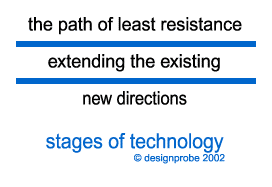|
 |
The Stages of Technology
John Naisbitt in his book Megatrends outlines 3 stages of technology.
1 The Path of Least Resistance
2 Extending the Existing
3 New Directions
(Naisbitt, J. Megatrends; Warner Books; New York; 1982; Pages 19-20.)
The Path of Least Resistance
 Technologies are initially applied in ways to avoid threatening people. For example, the first microprocessors were in toys since children are more receptive to new ideas. Similarly, the first robots were used for jobs considered unsafe or too dirty for humans and to assist the disabled and the elderly. Through this process the chance of the technology being rejected is reduced. Technologies are initially applied in ways to avoid threatening people. For example, the first microprocessors were in toys since children are more receptive to new ideas. Similarly, the first robots were used for jobs considered unsafe or too dirty for humans and to assist the disabled and the elderly. Through this process the chance of the technology being rejected is reduced.
Extending the Existing
"...every innovation must pass through a primary phase in which the new effect is secured by the old method, amplified or modified by some new feature."
Marshall McLuhan; Understanding Media; P.292.
New Technologies extend the technologies they have been designed to supersede.
Typewriters
For example, Computer keyboards are a direct transfer from the typewriter. Similarly, early computers were often marketed purely as word processors, a direct extension of the typewriter.
The Fax Machine
In a parallel way, facsimile machines (‘fax’) are an extension of computer technology. Or more correctly, a ‘fax’ is a substitution for a modem that connects computer terminals located in separate locations. The ‘fax’ was designed primarily to cater for the Japanese. Their Kanji alphabet contains over 200 basic characters making it extremely difficult to produce a satisfactory computer keyboard. For this same reason, in preference to learning another language, the development of voice recognition and voice operated computer technology is proceeding at a rapid rate.
High Tech - High Touch
Naisbitt also cites the facsimile machine as an example of a prominent trend toward ‘high tech/high touch’. For each advance in terms of technology there is a corresponding advance in human touch involved. The ‘fax’ uses high-technology to send ‘visuals’ down the line of a telephone, but also incorporates the human touch of handwritten notes. This trend supports the path of least resistance model for technology through softening the impact of new technologies.
Infant Technology
This phase of extending existing or previous technologies parallels the growth pattern of life. We begin as infants and eventually grow into adults. In most cases the maturing of technology occurs in a similar way. The initial breakthrough is made bring a new form into existence, but it is not until further developments and possible completely new technology allows it to mature into a fully developed form. This transitory phase is often characterized by a title that highlights the technology that is replaced rather than recognition of a new form.
The Wireless
For example, the term ‘wireless’ highlights the radio’s derivation from the telegraph. Whereas each telegraph was physically connected by a wire, the radio was merely connected to a power point. This new technology was not fully developed until the development of the transistor enabled the radio to become truly portable. Without the physical connection of the ‘wire’, pocket radios, and later the ‘Walkman’, provided personal sound through the freedom to move.
The Horseless Carriage
Similarly, early motor cars were described as ‘horseless carriages’ due to the similarity in appearance of the cabin to the traditional cart. Later as the efficiency and speed of vehicles increased new shapes were developed. It is obvious in hindsight with the domination of cars, roads and the sprawl of our cities, the automobile is no longer recognizable as a ‘horseless carriage’.
Computerized Communications
The development of computerized communications developed in the past decade are curently seen as extensions to existing postal services, telephone or television sets. Home shopping that incorporates the use of two-way television is conceived as being a better version of catalogue sales books and computerized ticket reservation systems are seen as mere extensions of telephone extension systems. Television, once viewed as being a ‘movie theatre in the living room’ has simply been extended into cable television. Whilst the view of these items as enhancements on existing technologies is correct in many ways, this view is also a limiting belief on their true basis and potential.
(Reference: Sakaiya, Taichi; The Knowledge Value Revolution; Page 233.)
The Electronic Drawing Board
The current use of computers by Architects represents a corresponding pattern. Current software is based upon the drafting practices of the drawing board - the technology that is being superseded. In preference to automating the drawing of plans, elevations and sections, new methods of describing building forms will be developed.
New Directions
New directions, uses or products are generated from the technology itself.
Computer Technology
The emergence of computer technology is still in its infancy, but a number of new directions are beginning to emerge. These may include:
• The Internet to replace stand alone computers
• Virtual Reality to replace Television.
• Automation to replace human employment.
• Neural Networks to replace Binary Computers.
Voice Recognition
One particular feature that will transform the use of computers into new directions and uses is to replace the use of keyboards with voice-operated commands. This breakthrough may have the equivalent effect of the transformation from ‘wireless’ to ‘Walkman’. In preference to needing deskspace or other flat surfaces for effective operation, the computer will become physically attached to its user, offering a whole new range of possibilities. For the same reason mentioned previously for the development of the fax, it is little wonder the Japanese are leading the way in this area of technology.
|
 |
| |
|
|

|
|

